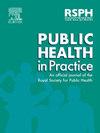Factors influencing type of contraceptive use among Ghanaian males: Insights from the 2022 Ghana demographic and health survey
IF 1.9
Q2 PUBLIC, ENVIRONMENTAL & OCCUPATIONAL HEALTH
引用次数: 0
Abstract
Objectives
This study examines the socio-demographic, media, and health-related factors influencing contraceptive use among men of reproductive age in Ghana.
Study design
The 2022 GDHS consists of three datasets which are nationally representative cross-sectional data that elicited the demographic and health indicators of children 0–59 months, women 15–49 years of age, mean aged 15–59 years old as well as households.
Methods
This study utilised the 2022 Ghana Demographic and Health Survey (GDHS) men recode file, analysing a sample of 7044 men aged 15–59 years. The dependent variable, contraceptive use, was categorised into modern, traditional, and no method. Data were weighted and cleaned, and multinomial logistic regression was used to identify factors associated with contraceptive use.
Results
Among the respondents, 16.6 % used modern contraceptives, 4.3 % used traditional methods, and 79.0 % used no method. Significant predictors of contraceptive use included age, education, ethnicity, region, marital status, wealth index, number of wives/partners, and media exposure (p < 0.05). Men aged 15–54 were more likely to use modern methods, while those with lower education levels were more likely to use no method. Ethnic differences were observed, with Mole-Dagbani men more likely to use modern methods. Media exposure, particularly frequent radio and television consumption, was positively associated with modern contraceptive use.
Conclusions
The persistently low uptake of modern contraceptives among men in Ghana hampers efforts to achieve universal access to family planning. Tackling socio-demographic disparities and strengthening media-driven awareness can foster greater male involvement. These findings highlight the need for targeted strategies to enhance male contraceptive use and support shared responsibility in family planning.
影响加纳男性避孕药具使用类型的因素:来自2022年加纳人口和健康调查的见解
目的:本研究探讨了影响加纳育龄男性避孕药具使用的社会人口统计学、媒体和健康相关因素。2022年全国人口健康调查包括三个数据集,这些数据集是具有全国代表性的横截面数据,其中包括0-59个月儿童、15-49岁妇女、平均年龄15-59岁以及家庭的人口和健康指标。方法本研究利用2022年加纳人口与健康调查(GDHS)男性编码文件,分析了7044名年龄在15-59岁之间的男性样本。因变量避孕措施的使用分为现代、传统和无方法。对数据进行加权和清理,并使用多项逻辑回归来确定与避孕药使用相关的因素。结果调查对象中使用现代避孕方法的占16.6%,使用传统避孕方法的占4.3%,未使用避孕方法的占79.0%。避孕措施使用的重要预测因素包括年龄、教育程度、种族、地区、婚姻状况、财富指数、妻子/伴侣数量和媒体接触(p <;0.05)。年龄在15-54岁之间的男性更有可能使用现代方法,而受教育程度较低的男性更有可能不使用任何方法。种族差异被观察到,摩尔-达格巴尼族男性更倾向于使用现代方法。媒体接触,特别是频繁的广播和电视消费,与现代避孕药具的使用呈正相关。结论加纳男性对现代避孕药具的持续低使用率阻碍了普及计划生育的努力。解决社会人口差异和加强媒体推动的意识可以促进更多的男性参与。这些调查结果强调需要有针对性的战略,以加强男性避孕药具的使用和支持计划生育中的共同责任。
本文章由计算机程序翻译,如有差异,请以英文原文为准。
求助全文
约1分钟内获得全文
求助全文

 求助内容:
求助内容: 应助结果提醒方式:
应助结果提醒方式:


